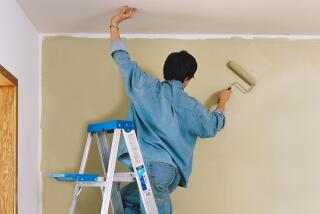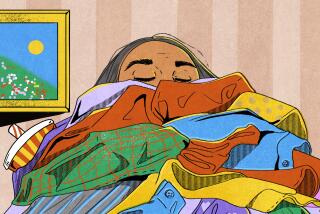Clean Up Your Act
- Share via
Pam McClellan knows what it’s like to be a slave to housework. Her dark brown carpeting required vacuuming every day. Decorative shelves held “a lot of dust-collecting items. I had crystal I had to be constantly dusting, and silver I had to polish. And my oak-and-glass end tables mixed wood, which requires one kind of maintenance, with glass, which requires another.” She also had “tons and tons” of plants in her home near Nashville.
“I would spend all this time cleaning,” McClellan recalls. “It was robbing me of time to pursue other things.”
When the family moved, McClellan changed from “a cozy, somewhat cluttered style” to one that is “streamlined and minimalist.” She installed peach carpeting. She gave away her plants, pared down knickknacks, and jettisoned other items. Although the new house was larger, it required less cleaning time.
McClellan is in the vanguard of a new approach to family home maintenance. Instead of simply finding more efficient ways to clean, she and others are devising more efficient ways to decorate that will simplify cleaning. Getting rid of clutter stands at the top of the list.
“The biggest thing people complain about is ‘stuff,’ ” says Don Aslett, author of “Clutter’s Last Stand” (Writers Digest, 1984). Forty percent of all cleaning time, he claims, involves “moving and resituating stuff.”
McClellan, author of “Don’t Be a Slave to Housework” (Betterway Books, 1995), understands that indecision. “Sentimentality is a big issue. People say, ‘I can’t get rid of that.’ I’m a softy, too, but I knew at some point I had to make a choice.”
Making choices also involves selecting easy-care flooring, counter tops, fabrics and finishes. As Paula Jhung, author of “How to Avoid Housework” (Fireside, 1995), explains, “There’s a lot that can be done with materials to repel dust and dirt or camouflage it.”
To reduce maintenance, the Jhungs take off their shoes in the house. The Carpet and Rug Institute, she notes, estimates that 80% of all dust and dirt comes in on the soles of shoes.
Jhung also relies on camouflage. A rug under the dining-room table features colors “from the four major food groups”--predominantly deep red, with green, tan and white. “If it doesn’t get vacuumed as often as it should, you can’t tell the lint and the crumbs from the design.”
In the family room, Jhung slipcovered a favorite chair in a fabric “that matches my cat pretty well. Now cat hair doesn’t haunt me.” And she replaced russet carpeting with camel-colored carpeting that makes dog hair from the family’s golden retriever less noticeable. “Every time you replace something, you’ve got to think, ‘Is this going to make my life easier?’ ”
Other cleaning experts devise their own labor-saving methods. For Aslett, that includes building a “maintenance-free” house in Hawaii. “One of the big, big ways to get rid of cleaning is to design it out,” he says. For example, showers in the house have a round design that eliminates the need for shower doors and curtains.
For Patti Barrett, author of “Too Busy to Clean?” (Storey Communications, 1990), housekeeping efficiencies are more modest. Because she “hates to dust,” Barrett bought furniture with painted finishes. “None of that polished wood,” she says.
Other creative disguises abound. Under a category she describes as “how to make your house look neat without being really clean,” Barrett offers two tips. One comes from her aunt, who dubbed her emergency-cleaning measures “the white tornado approach.” As Barrett explains, this involves “gathering up everything lying where it doesn’t belong, stuffing it in a bag, and putting the bag away.” Her aunt also believed in making everything smell good. “She was big on putting lavender everywhere--not a chemical scent, but a nice herbal scent.”
Another way to distract attention from dust and disorder, Barrett says, is available at a florist: “A lot of people say they get flowers and put them in the room, and that makes them feel better.”






